Reunification Day
| Reunification Day | |
|---|---|
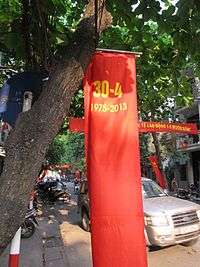 Banner in Hanoi for Reunification Day | |
| Official name | Day of liberating the South for national reunification (Giải phóng miền Nam, thống nhất đất nước) |
| Also called |
Reunification Day (Ngày Thống nhất) Liberation Day (Ngày Giải phóng) Victory Day (Ngày Chiến thắng)[1] Black April (Tháng Tư Đen) Fall of Saigon (Sài Gòn Thất thủ) |
| Observed by | Vietnamese |
| Type | National |
| Significance | Marks the liberation the South for national reunification |
| Observances | Vietnamese |
| Date | April 30 |
| Next time | 30 April 2019 |
| Frequency | annual |
| Related to | Liberation of Saigon |
Reunification Day (Vietnamese: Ngày Thống nhất), Victory Day (Ngày Chiến thắng) or Liberation Day (Ngày Giải phóng or Ngày Giải phóng miền Nam) or the official name of Day of liberating the South for national reunification (Giải phóng miền Nam, thống nhất đất nước)[2] is a public holiday in Vietnam that marks the event when Việt Cộng and North Vietnamese troops captured Saigon (now Ho Chi Minh City) on April 30, 1975. This signalled the end of the Vietnam War, known in Vietnamese as Chiến tranh Việt Nam (Vietnam War) or Kháng chiến chống Mỹ cứu nước ("Resistance War Against American invasion"). It was the start of the transition period toward reunification, which occurred in the national election for national reunification on July 2, 1976, when the Provisional Revolutionary Government of the Republic of South Vietnam and Democratic Republic of Vietnam merged, forming the modern-day Socialist Republic of Vietnam.[3]
The anniversary is marked by several festivals around the date.
In the Overseas Vietnamese community, the day is remembered as the "Fall of Saigon", "Black April" (Tháng Tư Đen),[4][5][6][7][8][9] "National Day of Shame" (Ngày Quốc Nhục) or "National Day of Resentment" (Ngày Quốc Hận).[5][10][11][12][13] This is a commemorative day for exiled Vietnamese who served, were affected, and displaced in those overseas communities, and as such is a day of reflection. Many Americans of multiple ethnicities observe the day for remembrance and solidarity.
Gallery
- The Statue of Victory April 30, 1975 at the Museum of Ho Chi Minh Campaign
- Vietnamese-American Heritage Flag (flag of the former Republic of Vietnam) lining El Cajon Blvd in San Diego, CA, leading up to Black April
- A sign in Hanoi, 2009, depicting the moment a Viet Cong tank crashed into the Presidential Palace on April 30, 1975.
_Democracy%2C_Human_Rights_Rally_63.jpg) Black April pro-democracy and human rights protest, held in remembrance of the Fall of Saigon on April 30, 2012, in Ottawa, Canada
Black April pro-democracy and human rights protest, held in remembrance of the Fall of Saigon on April 30, 2012, in Ottawa, Canada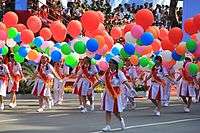 Children marching in the 40th anniversary of the day of liberating the South for national reunification
Children marching in the 40th anniversary of the day of liberating the South for national reunification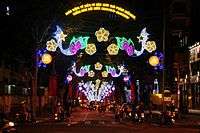 Decorating lights for the 40th anniversary of the day of liberating the south for national reunification on Đồng Khởi Street, Hồ Chí Minh city
Decorating lights for the 40th anniversary of the day of liberating the south for national reunification on Đồng Khởi Street, Hồ Chí Minh city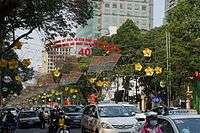 Decorating lights for the 40th anniversary of the day of liberating the south for national reunification on Lê Duẩn Street, Hồ Chí Minh city in daylight
Decorating lights for the 40th anniversary of the day of liberating the south for national reunification on Lê Duẩn Street, Hồ Chí Minh city in daylight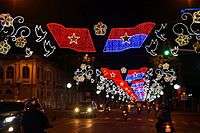 Decorating lights for the 40th anniversary of the day of liberating the south for national reunification on Lê Duẩn Street, Hồ Chí Minh city
Decorating lights for the 40th anniversary of the day of liberating the south for national reunification on Lê Duẩn Street, Hồ Chí Minh city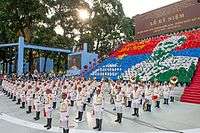 Military band in the 40th anniversary of the day of liberating the South for national reunification
Military band in the 40th anniversary of the day of liberating the South for national reunification Special forces marching in the 40th anniversary of the day of liberating the South for national reunification
Special forces marching in the 40th anniversary of the day of liberating the South for national reunification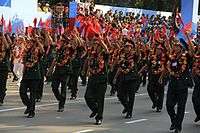 Veterans in the 40th anniversary of the day of liberating the South for national reunification
Veterans in the 40th anniversary of the day of liberating the South for national reunification
See also
- Public holidays in Vietnam
- Liberation Day in other countries
- Victory Day in other countries
Videos
References
- ↑ "Bộ Luật lao động 2012". Thuvienphapluat.vn. Retrieved 2018-04-30.
- ↑ Tin Liên Quân (2016-05-01). "Nhiều hoạt động kỷ niệm 41 năm ngày Giải phóng miền Nam, thống nhất đất nước (30/4/1975 – 30/4/2016)". Hànộimới. Retrieved 2018-04-30.
- ↑ "5. Cuộc tổng tuyển cử ngày 25 tháng 4 năm 1976 đánh dấu bước thắng lợi quyết định của nhân dân ta trên con đường thống nhất nước nhà về mặt nhà nước (Ngày 24 tháng 6 năm 1976)". Dangcongsan.vn. Retrieved 2018-04-30.
- ↑ "Black April". Los Angeles Times. Retrieved December 7, 2013.
- 1 2 "Black April". UNAVSA Knowledge. Retrieved December 7, 2013.
- ↑ "Black April". VNAFMAMN. Retrieved December 7, 2013.
- ↑ Secretary of State. "Assembly Concurrent Resolution No. 220 Chapter 74 Relative to Black April Memorial Week". Legislative Counsel's Digest. California Legislative Information. Retrieved December 7, 2013.
- ↑ Kurhi, Eric. "Black April ceremony honors Vietnam War soldiers in San Jose". San Jose Mercury News. Retrieved December 7, 2013.
- ↑ Bharath, Deepa (April 29, 2011). "O.C. Black April events commemorate fall of Saigon". Orange County Register. Retrieved December 7, 2013.
- ↑ Bharath, Deepa (April 25, 2008). "Black April events commemorate fall of Saigon". Orange County Register. Archived from the original on May 18, 2009. Retrieved May 28, 2009.
- ↑ "Audio Slideshow: Black April". Los Angeles Times. Retrieved May 28, 2009.
- ↑ Trần, Mỹ-Thuận (April 30, 2009). "Orange County's Vietnamese immigrants reflect on historic moment". Los Angeles Times. Retrieved May 28, 2009.
- ↑ Dzũng, Đỗ (April 30, 2009). "Tưởng niệm Tháng Tư Đen ở Quận Cam". Báo Người Việt. Archived from the original on May 2, 2009. Retrieved May 28, 2009.